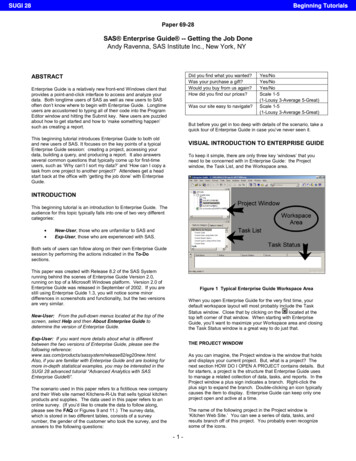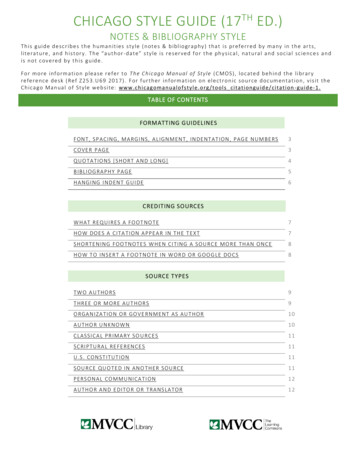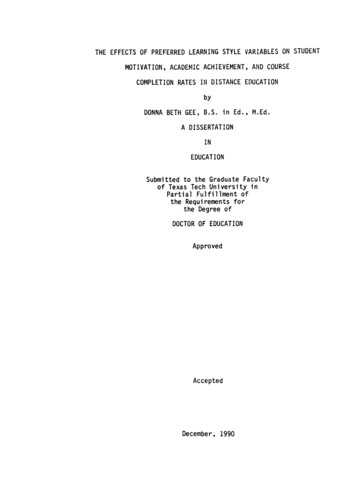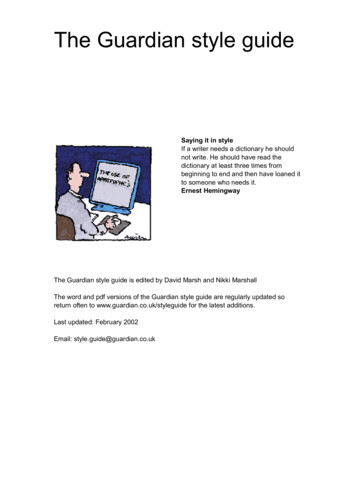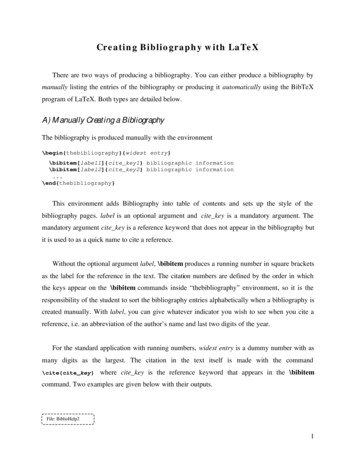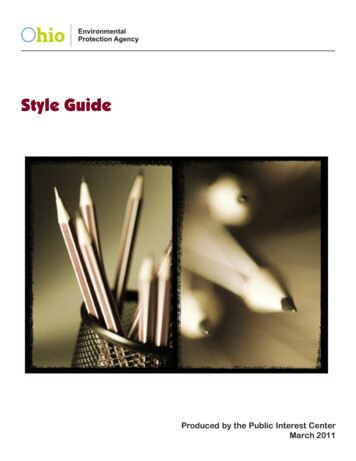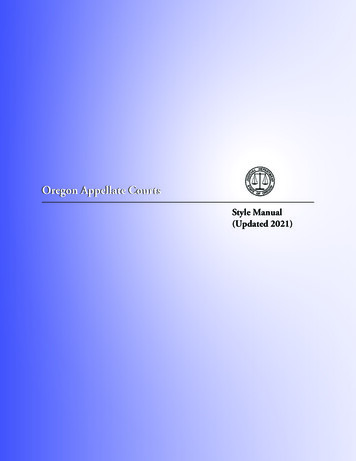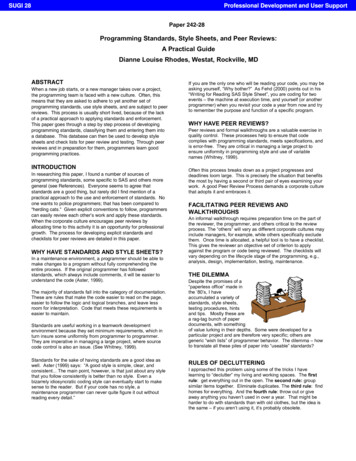
Transcription
SUGI 28Professional Development and User SupportPaper 242-28Programming Standards, Style Sheets, and Peer Reviews:A Practical GuideDianne Louise Rhodes, Westat, Rockville, MDABSTRACTWhen a new job starts, or a new manager takes over a project,the programming team is faced with a new culture. Often, thismeans that they are asked to adhere to yet another set ofprogramming standards, use style sheets, and are subject to peerreviews. This process is usually short lived, because of the lackof a practical approach to applying standards and enforcement.This paper goes through a step by step process of developingprogramming standards, classifying them and entering them intoa database. This database can then be used to develop stylesheets and check lists for peer review and testing. Through peerreviews and in preparation for them, programmers learn goodprogramming practices.INTRODUCTIONIn researching this paper, I found a number of sources ofprogramming standards, some specific to SAS and others moregeneral (see References). Everyone seems to agree thatstandards are a good thing, but rarely did I find mention of apractical approach to the use and enforcement of standards. Noone wants to police programmers; that has been compared to“herding cats." Given explicit conventions to follow, programmerscan easily review each other’s work and apply these standards.When the corporate culture encourages peer reviews byallocating time to this activity it is an opportunity for professionalgrowth. The process for developing explicit standards andchecklists for peer reviews are detailed in this paper.WHY HAVE STANDARDS AND STYLE SHEETS?In a maintenance environment, a programmer should be able tomake changes to a program without fully comprehending theentire process. If the original programmer has followedstandards, which always include comments, it will be easier tounderstand the code (Aster, 1999).The majority of standards fall into the category of documentation.These are rules that make the code easier to read on the page,easier to follow the logic and logical branches, and leave lessroom for interpretation. Code that meets these requirements iseasier to maintain.Standards are useful working in a teamwork developmentenvironment because they set minimum requirements, which inturn insure some uniformity from programmer to programmer.They are imperative in managing a large project, where sourcecode control is also an issue. (See Whitney, 1999).Standards for the sake of having standards are a good idea aswell. Aster (1999) says: “A good style is simple, clear, andconsistent. The main point, however, is that just about any stylethat you follow consistently is better than no style. Even abizarrely idiosyncratic coding style can eventually start to makesense to the reader. But if your code has no style, amaintenance programmer can never quite figure it out withoutreading every detail.”If you are the only one who will be reading your code, you may beasking yourself, “Why bother?” As Fehd (2000) points out in his“Writing for Reading SAS Style Sheet”, you are coding for twoevents – the machine at execution time, and yourself (or anotherprogrammer) when you revisit your code a year from now and tryto remember the purpose and function of a specific program.WHY HAVE PEER REVIEWS?Peer reviews and formal walkthroughs are a valuable exercise inquality control. These processes help to ensure that codecomplies with programming standards, meets specifications, andis error-free. They are critical in managing a large project toensure uniformity in programming style and use of variablenames (Whitney, 1999).Often this process breaks down as a project progresses anddeadlines loom large. This is precisely the situation that benefitsthe most by having a second or third pair of eyes examining yourwork. A good Peer Review Process demands a corporate culturethat adopts it and embraces it.FACILITATING PEER REVIEWS ANDWALKTHROUGHSAn informal walkthrough requires preparation time on the part ofthe reviewer, the programmer, and others critical to the reviewprocess. The “others” will vary as different corporate cultures mayinclude managers, for example, while others specifically excludethem. Once time is allocated, a helpful tool is to have a checklist.This gives the reviewer an objective set of criterion to applyagainst the program or code being reviewed. The checklists willvary depending on the lifecycle stage of the programming, e.g.,analysis, design, implementation, testing, maintenance.THE DILEMMADespite the promises of a“paperless office” made inthe ‘80’s, I haveaccumulated a variety ofstandards, style sheets,testing procedures, hintsand tips. Mostly these area rag-tag bunch of paperdocuments, with somethingof value lurking in their depths. Some were developed for aparticular project and are therefore very specific; others aregeneric “wish lists” of programmer behavior. The dilemma – howto translate all these piles of paper into “useable” standards?RULES OF DECLUTTERINGI approached this problem using some of the tricks I havelearning to “declutter” my living and working spaces. The firstrule: get everything out in the open. The second rule: groupsimilar items together. Eliminate duplicates. The third rule: findhomes for everything. And the fourth rule: throw out or giveaway anything you haven’t used in over a year. That might beharder to do with standards than with old clothes, but the idea isthe same – if you aren’t using it, it’s probably obsolete.
SUGI 28Professional Development and User SupportAPPLYING THE RULES TO STANDARDSFORMSThe first task was to locate copies of all the standards, rules,and tips I wanted to include. This meant I had to dig through filesand piles of papers to find all the goodies I wanted to include inthis project. I also printed out variousSUGI and NESUG papers appropriate tothe subject. The second task: put likeobjects together, i.e. Classify them. Iinitially defined four groups of rules:documentation, efficiency, maintenance,and testing (with some overlap). Thethird task: put them into a database. Ielected to use MS Access because itwas quick and easy and I could give thedata entry work to someone who wasn’tfamiliar with SAS. SAS was used to develop more complexreports and checklists. I also tried to operationalize the rules,that is, give working examples. The fourth task: I eliminatedsome rules that were vague or subjective such as “avoidunnecessary branches.”The main form was a simple data entry form. Here the usertranscribes from a paper cheat sheet the key elements of the tip,trick, or standard.CORPORATE STANDARDSDoes your company have corporate standards? When I askedthis question of my colleagues, the answer was no. Did I want tobe the one to try to create corporate standards? No. For thisreason, I decided to keep most of my styles and tips prettygeneral, instead of implementing specific rules. For example, Isuggest that it is useful to indent code to show logical flow. But Idon’t specify a style, since I don’t really care what style is used aslong as it is used consistently.REPORTSThe first report is simply a hard copy of the database, as shownin Programming Tips and Tricks in the Appendix. These arelisted by tip number, which is simply the order in which they wereentered into the database. I included another tip number field inthe database, so that I could change the order of the tips at afuture date.THE TIPS DATABASEWorking from various paper documents, I roughed out adatabase. The fields were tip number, type, the rule, an example,and the rationale for the rule. I quickly added check boxes forPeer Review and Testing, and a field to store the author orsource. This allows for the generation of various checklists forpeer reviews, testing procedures, etc. and customization byselecting certain subgroups. The Appendix contains examples ofa document to present tips and standards, checklists used forpeer reviews and testing, and a report that can be used as a stylesheet.The Style Sheet is a list of the tips, primarily those related todocumentation.The Peer Review checklist was produced from a query thatselected the tips where the Peer Review check box was checked.It is a quick list for programmers to review when they are deskchecking a program.The types that I defined were:Documentation. Tips or standards that help document thepurpose of the code and make it easier to read.Efficiency. Tips to make the code more efficient; that is to runfaster.Maintenance. Tips to make the code easier to maintain. Thesesometimes are contrary to the efficiency tips!Testing. These tips mainly concerned testing issues, or things tolook for when testing. This is an area I would like to continue toenhance.The Testing checklist was produced from a query where the Testcheck box was checked. It is a list for review when testing aprogram, which could be stress testing, parallel testing beforeputting a program into production, etc.ENHANCEMENTSThe major enhancement I plan to make is to create another tableand input form to allow programmers to interact with the PeerReview and Test checklists while desk checking a program. Thiswould allow them to check off that a program is in compliance orneeds work in a particular area.CONCLUSIONOrganizing standards and style sheets can be an onerous task,but it’s a necessary requisite to implementing their use. Puttingthem all into one place, cleaning them up, and having themwhere they are accessible to the programming staff is part of theprocess of learning good programming practices.DISCLAIMER: The contents of this paper are the work of theauthor(s) and do not necessarily represent the opinions,recommendations, or practices of Westat.2
SUGI 28Professional Development and User SupportREFERENCESAster, Rick (1998).“Coding for Posterity.” In the 11th AnnualProceedings of the NorthEast SAS Users l/p131.pdfCarpenter, Arthur L. (1999). “Getting More for Less: A Few SASProgramming Efficiency Issues.” In the 12th Annual Proceedingsof the NorthEast SAS Users C199.PDFCheng, Alice M. (1999).“Robust Programming Techniques in theSAS System.” In the 12th Annual Proceeding of the NorthEastSAS Users PO159.PDFFehd, Ronald J. (2000). “The Writing for Reading SAS StyleSheet: Tricks, Traps & Tips from SAS-L’s Macro Maven.” In the25th Annual Proceedings of the SAS Users Group 25/25/ad/25p038.pdfWhitney, C. Michael (1999) “Taming the Chaos: Managing LargeSAS/AF Applications Using Programming Standards and theSource Control Manager of Version 7 of the SAS System.” In the24th Proceedings of the SAS Users Group 24/AppDevel/p10-24.pdfACKNOWLEDGMENTSI want to thank Duke Owen for giving me the opportunity to teacha class on programming best practices at Westat. This gave methe time to research and put together some of the ideaspresented here. I extend my appreciation to The Macro Mavenas a valuable resource and thanks for reading my first drafts andwhispering SQL in my ear.CONTACT INFORMATIONComments, questions, and additions are welcomed.Contact the author at:Dianne Louise RhodesWESTATAn Employee-Owned Research Corporation1650 Research Blvd.Rockville, MD 20850Phone: (301) 315-5977Email: diannerhodes@westat.comMy intent was to include a copy of this MS Access databasewith the SUGI 28 proceedings. However, if it is not available,contact me and I can provide it for you.3
SUGI 28Professional Development and User SupportAppendix of Reports4
SUGI 28Professional Development and User Support5
in Programming Tips and Tricks in the Appendix. These are listed by tip number, which is simply the order in which they were entered into the database. I included another tip number field in the database, so that I could change the order of the tips at a future date. The Style Sheet is a list of the tips, primarily those related to documentation.
